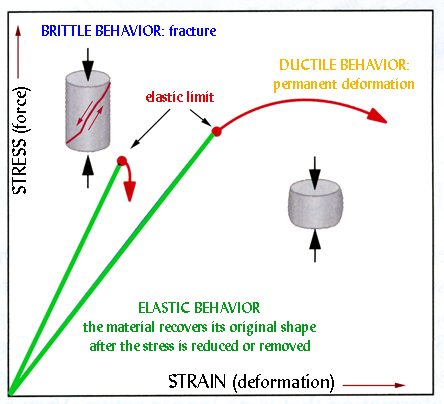Structural Geology and Tectonics. What are they?
Structural Geology and Tectonics are two branches of geology that are closely related, and that deal with the reconstruction of the different kinds of movements that have occurred over time in the Earth's lithosphere.
Both words reflect a similar meaning:
- the word Structure comes from the Latin struere, to build
- the word Tectonics from the Greek tektos, builder.
Both terms are hence related to the motions and processes involved in the build-up and deformation of Earth's crust.
These could simply consist in the movement of a rock body from one location to another, without any change in shape or size; but they could also be different kinds of deformation that break or bend a rock, causing a permanent,non-reversible change.
Why do we need to know about structural geology and tectonics?
By knowing under what conditions these motions occur and how these deformations are originated, we can get information that is very useful in the reconstruction of the history of Earth's crust. Think in terms of big scale (plate motion), medium-size scale (the building of a mountain), and small scale (a local deformation, caused for instance by a small earthquake).
Is there any difference between structural geology and tectonics? Why do we use two terms?
The concept is the same: both branches deal with the study of permanent deformation caused by motion in Earth's lithosphere, so that Earth's history can be inferred.
The difference is that structural geology deals predominantly with the study of deformation at a small scale, from submicroscopic (for instance, deformation that occurs in minerals and rocks) to regional (for instance, deformation in small local areas).
Tectonics instead deals with deformation on a global scale, for instance at the level of a whole region (say, the Colorado Plateau, or the Basin and Range area, or the Los Angeles Basin), or a continent, or a whole plate.
Structural geology and tectonics are not indipendent one from the other: observations made in minerals and rocks, and in small areas, must fit the general picture of plate tectonics. Observation made at a plate level, that is motions and deformations at large scale, must be reflected at the local level too.
How do we study Earth's crust deformation?
The study of lithosphere's deformation has improved enormously in the last fifty years, changing from mostly descriptive (qualitative) to more and more quantitative. Continuum mechanics, laboratory deformation testing, the use of mathematical models, the increasing amount of geophysical data at hand (such as seismic, gravity, magnetic), the increased availability of satellite images, of airborne and spaceborne radar data, have all contributed to this change. Other branches of geology, such as petrology, geochemistry, sedimentology, stratigraphy, and paleontology also provide a limitless source of data for tectonic studies.
For the purposes of this class, we will follow mainly a descriptive approach, using mathematics only when necessary.
| |
| Deformation: Brittle and Ductile | Last Updated • November 22, 2011 |
|
We said in the previous section that we are interested in studying the deformations that occur in Earth's lithosphere. These deformations originate different types of tectonic structures, as a function of, for instance:
- the orientation of the forces applied to the rocks
- the intensity of the forces applied to the rocks
- the motions to which the rocks are subjected as a consequence of the type of deformation
- the physical conditions, such as the temperature and pressure, under which the rocks are deformed
- the mechanical properties of the rocks, which are strongly affected by the physical conditions (hot/cold, wet/dry) and the type of rock (igneous/metamorphic/sedimentary)
In the upper part of the lithosphere, close to the surface, or in general at relatively low temperatures and pressures, and at high intensity of applied forces or a rapidly imposed deformation, rocks break: this is a brittle deformation. Brittle deformation implies fracturing of the rock. If there is a fracture, it means that your rock loses cohesion (it breaks, chemical bonds are broken, atoms are separated) along a surface (the fracture plane). If the two sides of a fracture do not slide relative one to the other then you have a simple fracture, or joint. If instead the two sides slide relative to each other along the fracture surface, then you have a fault.
Under very different conditions, in the lower part of the lithosphere, or in general at relatively high temperatures and pressures (but still below the melting point), and at a relatively low intensity of applied forces or a very slow imposed deformation, rocks flow, or change shape: this is a ductile deformation. Ductile deformation implies bending, folding, stretching, thinning of rocks, and aligning of grains. A common, generic tectonic structure that develops following ductile deformation is a fold.

[modified from Plummer, C.C., and Carlson, D.H., 2008. Physical Geology (12thed.), McGraw-Hill]
This diagram shows how a body subject to stress (an external force) is subject to a physical change (a strain, or deformation).
If upon removal of the stress the strain disappears, the body reacquires its original shape.
In this case, we talk of elastic behavior.
If instead the stress goes beyond what we call the elastic limit, then the deformation becomes permanent:
if the body breaks, or fractures, we have a brittle behavior (our body is fragile);
if the body bends, or is irreversibly deformed, we have a ductile behavior (our body is plastic).
Go to part 2 | Go to part 3 |Go to the Images & Notes Page | Go to the Home Page
© Alessandro Grippo, 2011 (original layout: March 26, 2008) |

